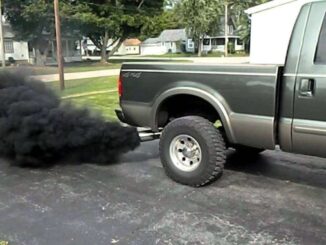
Valve stem seals, control the lubrication of the valve stem, as it moves up and down in the valve guide.
By specific design, all valve stem seals are made to include, a precisely controlled leak.
But, if too little oil flows past the valve stem seals, the valve stem and valve guides will wear. However, if too much oil flows past the valve stem and valve guides, oil consumption increases.
Furthermore, faulty valve stem seals, can cause a buildup of carbon, leading to valve, seat and guide damage.
Consequently, as the engine wears oil consumption or smoke, would be the first sign of a problem.
There are two basic types of valve stem seals
Valve stem seals, come in two basic types, umbrella seals (also known as deflector seals) , and positive seals.
1. Umbrella Seals (also know as deflector seals)
Umbrella or Deflector seals, like the name implies, deflect oil away from the valve stem. Also, they move with the valve stem, to shield the valve guide from excess oil. Deflector seals are a simple and effective design, and are easy to install.
2. Positive Seals
So, you will see positive type valve stem seals, on most late model engines. Consequently, because of better emissions and oil control. A positive valve stem seal, provides a tighter seal, which reduces the amount of oil that enters the guides. This minimizes oil consumption, and hydrocarbon emissions. Also, helps to keep intake vacuum high, for better idle quality. Worn valve guides and seals, will allow air to leak. As a result, causing a lean misfire, and a rough idle.
So, overhead camshaft engines (OHC), require positive valve stem seals. Because, a positive seal, will prevent oil from flooding the guides.
Unlike an umbrella seal, a positive seal does not move. The seal does not actually make, direct contact with the stem. But, actually rides on a thin film of oil, creating a hydrodynamic seal. This allows a small amount of oil, to slip past the seal to lubricate the guide. For this reason, a precise fit is extremely important, to get accurate oil metering.
Emission control regulations
Increasingly stringent emissions regulations, make it imperative, that oil not enter the combustion chamber.
Diagnosis valve stem failure symptoms, under different conditions
When valve stem seals begin to wear or fail, they produce some obvious and unique symptoms:
Cold Engine
One excellent way to tell if you have a faulty valve seal, is to perform a cold engine test. Let your vehicle sit overnight. The top of the head, will have some oil left over, from the last time you drove. The oil, will slowly seep past the valve seal. And, at some point, it will end up in the combustion chamber. As a result, smoke out the exhaust, is the end result.
Idling And Or, Stop And Go Driving
Bad valve seals, will show themselves, during excessive idling at stop signs or stop lights in congested conditions. When the vehicle sits at idle for excessive periods, high levels of vacuum at the intake manifold result. Because, the throttle valve remains closed.
The high vacuum attracts oil in the heads, to congregate around the valve stems. Then, problems happen during acceleration. Firstly, the oil passes by the worn valve stem seal. Next, it passes by the valve guide. Huge clouds of blue white smoke exit the exhaust pipe, after each acceleration from a stop. However, the burning smoke will disappear, during cruising or highway speed.
Excessive Oil Consumption
Bad valve stem seals will cause, excessive oil consumption. In an otherwise normal engine, with good compression, rings and valve guides, bad seals will cause, a loss of oil. Also, a poor or damaged (PCV) could add to it.
Excessive Smoke
If the valve seals have deteriorated enough, the blue exhaust smoke, will last longer after start up and acceleration. Yet the smoke will eventually disappear, after long engine operation or during periods of hot weather.
Bad valve seals nearly always show, an intermittent problem of oil burning. However, worn piston rings and valve guides will smoke, during all times of engine operation, and never disappear.
Off Throttle Braking Or Coasting
During off throttle braking, worn valve stem seals, will show their ugly face. Especially, when going down a steep hill, where the gas pedal remains static. Also, with the creation of high intake manifold vacuum, coupled with the down hill slant of the engine.
As a result, oil collects toward the front of the valve cover. Upon pushing on the gas pedal after a long coast, burned oil will exit the exhaust pipe in copious amounts. And, in this case, the engine will continue to burn oil for a longer period of time. But, it will still be a temporary condition, until finally the smoking stops, under normal cruise.
Lack Of Acceleration Power
So, the final indicator of a poor valve seal, is a lack of acceleration power. You can also perform, a compression test to see if this is the case. A higher level of compression, will indicate, that it’s a valve seal problem. However, a low level of compression, will indicate a piston ring problem.
Conclusion
So, valve stem seals, play a critical role in controlling, valve lubrication, as well as oil consumption.
Finally, with worn or poorly installed valve seals:
- The valve guides, may be starved for oil.
- The valve guides, may be flooded with oil.
Either way, the engine is going to have problems.
BY DANNY BENDER




